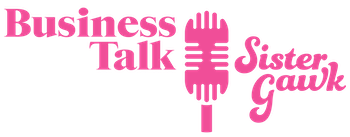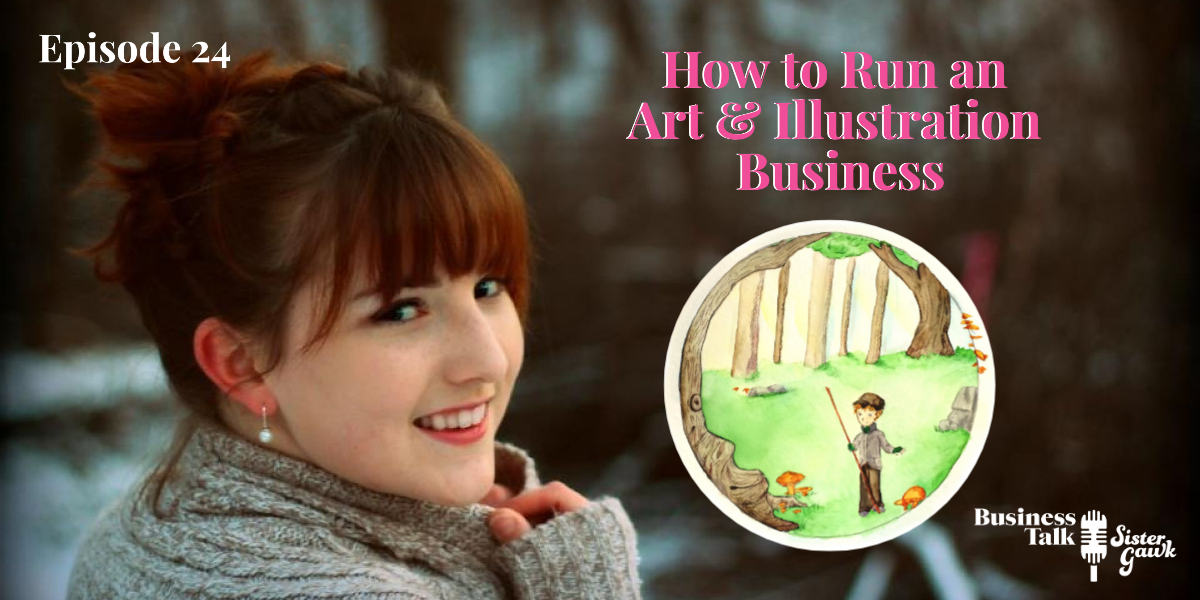In this episode, we hear from artist Katie Allen as she tells us about how she uses different tools to run her art business and the processes she has in place for doing book illustrations. From the tools to get paid, to knowing how to scope out a good craft show for your products, Katie is a wealth of knowledge on running an art business.
Bekkah: Welcome to Business Talk Sister Gawk. I’m Bekkah.
Ruthie: And I’m Ruthie. Today we are going to be interviewing Katie Allen.
Bekkah: Yeah, I’m super excited about this. Katie has been a friend of mine for quite some time. She is an incredible artist. The first time I met Katie, probably, she had a ton of different designs that she was doing for people with face painting and she’s always had some kind of little design that she’s working on. She’s going to be telling us a little bit about the things that she’s used that for. So can you tell us what you do, Katie?
Katie: Sure, I am a freelance illustrator and what that means is that people come to me with projects of say, a children’s book or a poem that they want images to and I create those for them. And also on the side I do craft fairs, selling my own original artwork and things.
How Did You Get Started Doing Book Illustration?
Ruthie: Wow. So tell us a story. How did that come about that? How did you decide you wanted to illustrate books and do craft fairs and stuff like that?
Katie: I was born with very artistic parents. My dad has owned a shop at the Renaissance for years and years and years. He draws and does portraits and things and my mom is a costume designer on the side. And so art came naturally to me and I’ve always been sketching. I have sketchbooks back to when I was, like, six. In college, I decided to take a few art classes. I’m primarily self-taught. And after college, I was working in an after school program that wasn’t something that I loved. I was kinda looking for things to do on the side to keep me occupied. I say a post on an online bulletin saying “I need a children’s book illustrator” and I said, “Hey, I’m going to give this a shot.” And that kinda began the journey.
How To Find & Work With Book Illustration Clients
Ruthe: Yeah, so how do you do that? How does one find these people? Just find these mystery online billboards or how do you get clients?
Katie: Honestly it’s been kinda cut and paste and just really haphazard for me, personally. There are tons of online communities that you can be a part of as an illustrator that I haven’t looked into a lot, just because they are rather intimidating. But this one was on my church bulletin board and it was just a guy looking for an illustrator. And I thought, “You know, I’ll be open. I haven’t done this before. I’m open to working on this project.” Typically, now, I will sit down with a client.
When it’s not COVID-19 I will sit down across from them, at like a coffee shop and talk over the project with them. I have a price sheet of size of the illustration, black and white or color, full page or more of a thumbnail print. Think of big children’s book verses the illustrations of Narnia that are very small and compact. And then we’ll discuss what the project is and whether or not they can do that price range. I’m very flexible. And then we’ll take it from there.
What Medium Do You Start With to Do Book Illustrations?
Ruthie: Do you start with a digital copy or do you just throw some watercolor or pencil or do you just sit with them and talk about it?
Katie: Well, typically an author will have a script that they already have and have some Ideas of pictures that are already running through their minds so I’ll sketch those out a little bit on paper. And then I’ll go home with the script and I will make what is called a storyboard. I’ll go through and mark out different parts of the text for different pages and I will create ideas for those pages in random sketches and little boxes in my sketchbook.
After that is complete, I will run that by the author and ask if this is what they’re thinking. They’ll either say “yes or no I was thinking more that.” Then I will get down to business and start fully creating them. Typically I do physical watercolor. I’m just now breaking into digital art. It’s an entirely different beast.
What Processes Did You Create to Be a Commissioned Illustration Artist?
Bekkah: How did you figure out your processes for all of your stuff when you started meeting with people? Did you figure this out because you started learning, “These are the common things that people ask” and you just put a list together? Or how did you come up with that information and the pricing structure and all of that?
Katie: Yeah, it was really a try and fail kind of a thing. I did Google, like, “What should a meeting with this person look like” and like, “what should my pricing be” and that sort of thing. Pinterest has been a savior for that cause I’m not a technical person. I want to paint. If you pay me, awesome. But that doesn’t really pay the bills so I actually have to come up with a price sheet. So eventually I just kinda figured it out through reading a bunch of articles and like, “Ok, what do I want this thing to look like for me? What am I comfortable with?”
How Do You Get Paid As An Artist?
Ruthie: Awesome. And then how did you receive payments for that?
Katie: Well, if I’m illustrating a gig I will turn over physical copies or digital copies to the person, in person. And they will either write me a check or they pay me via PayPal. I have a little chip card reader that I like to use. I haven’t really gotten into online payment. I don’t know, it just isn’t something I’ve needed to do.
Ruthie: Ok. You said that you’re pretty flexible with things. How do you decide what is a passion project and you’re like, “oh yeah I would do this for any price” and what’s “I know this is going to be grueling and I have to make money on this for it to be worth it.”
Katie: I should point out I’ve only had four illustration projects so far so I haven’t had to decide between projects very much. And any project that has been given to me, I have mostly been happy to do if I felt comfortable with it.
What It’s Like to Use RedBubble As An Artist – A Personal Experience Review
Ruthie: Tell us a little bit about RedBubble. You were talking with Bekkah about that and I’m so curious about it. I’ve never even heard of RedBubble before.
Katie: Sure. RudBubble is an online platform for artists who upload their work digitally onto things like mugs or bath mats or backpacks. They’ve got a whole slew of things. What they do is take the artwork, and then they put it on a bunch of stuff. Not physically, just digitally. And when a customer is says, “Ooh I like that, I want that unicorn on a T-shirt,” say. They order that and RedBubble will fulfill that order. They have all shipping and the T-shirt making and everything in their little corner. And then the artist will get a chunk of that. So it takes all the stressful work away from the artist.
Ruthie: That’s awesome.
An Artist Entrepreneur Review of RedBubble and Etsy
Bekkah: I was looking a little bit at it after we had talked about it. And I thought, “Wow! There’s so many different artists on here that have stuff.” I knew you had talked a little bit about your experiences with Etsy and you were on there before. Can you tell us that whole process of, you got started with Etsy, you tried it out, what did you see for it? Was it a good fit? Or now you’re on RedBubble, what’s the pros and cons, all that kind of stuff?
Katie: Sure. Etsy is much more of a physical store online. So more of like an Amazon where they expect the seller to have mugs ready to send themselves. So actually I got the “How to sell on Etsy for Dummies” when I was starting because, guys, those books are amazing. I don’t know, I’m a little bit of a dummy.
Bekkah: I remember seeing that on your coffee table one time and was like, “Ooh.”
Katie: I have way too many of those books. It’s kind of a problem. But I read that and that was really helpful. I think I would have been truly lost getting started on Etsy without it. Etsy also charges their patrons. Etsy also charges their artists monthly and by post. Not very much, like, one or two dollars, or maybe fifty cents per post a month. But if you’re only getting, you know, one sell a month or maybe every couple months it’s not really worth it.
That’s the issue I was running into was that I didn’t have a lot of traffic on my page to make up for that cost. Also having to be the physical creator of that artwork. They didn’t make the T-shirts or the mugs. I was having to buy them wholesale and store them in our little tiny apartment under shoes and things just to keep them. And I was like, “This isn’t working out for where I’m at currently.”
What Are The Costs for Using RedBubble As An Artist?
Ruthie: Does RedBubble have a similar structure in that you have to pay per month or is it pay per sell or what does that look like?
Katie: There is a premium option, I believe, where if you paid you could get more towards the front of pages for search bars and things. But the basic package which I’ve found completely fine is absolutely free. Which is very much a blessing for artists who are just getting, you know, up and going.
Ruthie: Yeah, for sure. That’s like when we were talking about… What was it Bekkah? Direct to sale or direct to customer selling on Amazon? What was that called?
Bekkah: Fulfilled by Amazon.
Ruthie: Yeah Fulfillment by Amazon. It’s like it takes out all the work and it’s cheaper. So like, you’re literally being able to just draw the design and then printing it on all these tangible things instead of having to craft the entire thing yourself, every time. And not having to pay as much. So that’s pretty cool. I didn’t even know RedBubble was a thing so look at that. Learning new stuff. How did you hear about RedBubble?
Katie: It was through another friend of mine who also dabbles in creating artwork for mugs and T-shirts and things. She’s not an illustrator per say but she is an artist. And she was telling me, “You’ve got to try this. It’s free.” And I thought, “Hey, I’ll give it a shot.” And it’s treated me very well. I really like their platform a lot.
Bekkah: Nice. So, with the digital stuff. How do people normally go about marketing those things. Are there premium options?
Katie: I think so for RedBubble. Like I said, I’ve kind of been a little lazy on that account. Where I just post things on there and if people find it, great. I have been on Instagram promoting a few things every once in a while. Actually, I made my husband my PR head because he is very good in front of a crowd and I prefer not to do that. That is not my forte. So if you find me on Instagram, know that it is him talking for me but he always checks every post with me to make sure, “Hey, is this something that you would actually say?” And most of the time he gets it right.
Ruthie: I’m just laughing because, so we talked about this a little before but my first encounter with Chris Allen was at camp, getting to know him when he was in a costume nd literally coming down this… I didn’t even get to know him at that time honestly, but he was coming down this aisle wearing this Rafiki costume with his face painted and he’s like, holding this mop. And I’m like, just like, he’s got his body like, all like contorted and like hobbling down this hallway. Yeah and that’s the literally the extent of my knowledge about Chris Allen. So when you talk about him, Impressive monkey is my description of him. You were saying with such confidence and stuff. He really was the most confident monkey man I’d ever seen.
Katie: I will have to tell him you said that. [Laughing] He will take it as a high compliment, I am sure.
Ruthie: Good. I’m glad. That’s awesome. Yeah so with this project that you have been working on and all these fun things that you’ve really just been able to run with and do with excellence, which is so cool. I love that you’re figuring out all these things. I’ve seen some of your stuff and it’s so beautifully elegant and cute and I just love that. What is a memorable thing that has really stuck with you? That you think, “If someone were to do this, I would so recommend them doing this one thing.”
Katie: I am thinking. Hold on.
What Every Artist Entrepreneur Should Know:
Ruthie: Ok. It could also be something that you would avoid. Like, that you were like, “don’t do this.”
Katie: I would have to say my most memorable thing that I learned from my dad who is a portrait artist and has worked on commission a lot. He said, “Never work on a project that’s going to pay via book sales because you never know if that book is actually going to sell. And always get the money up front,” basically. He’s a bit of a cynic but it really helps to have a cynic artist as a dad. I love him. So that has helped a lot in a few projects that I have done. I have made sure to say, “Hey, I would prefer to work via the amount of pages verses book commission or the amount that the book sells.” And so far, every artist, so far every author has been very understanding of that.
How To Ask For Payment As An Artist
Ruthie: Yeah. And have those conversations been awkward to have? Like, right up front or not really?
Katie: It can be a little awkward to say, “Hey, show me the money” as I hand over these prints but I don’t know. I just try to come at it as the most respectful and most positive, upbeat way that is possible. Like, “I do not work on the percentage of the book sales. I have an upfront cost and that is by page or by illustration. Here is the list.”
Ruthie: Yeah, so when you post things on Instagram and things like that do you always refer back to “check out my Etsy channel?” Or have you used Instagram as your business?
Katie: I haven’t actually had any commissions come through from Instagram yet. Both my husband and I are pretty lax about posting there. We were pretty religious up until about March about posting, and then the world turned upside down. So I don’t think I’ve posted anything since March. But, yeah, typically on Instagram we’ll link to the shop and be like, “Hey, look at these other cool things on my Redbubble page and here’s the link.”
How To Got Started Selling Art At Craft Shows
Ruthie: How does that transfer over to craft shows? You talked a little bit about that and I love craft shows so I’m excited to hear about how you got started with that and what
you do.
Katie: Well, working with my dad at the Renaissance, working with his art really prepared me for that cause I got to see how you greet customers, how you work the crowd, so to say. And it just set me up for being my own little shop. My dad was very much there to give me pointers and teaching me how much supply I should buy beforehand because at craft fairs you do need an actual physical product to give the person. You can’t just be like, “Oh I’m going to have Redbubble send this to you.” So it was a little bit of an investment to purchase mugs and a few other things. I actually have three coloring books out there right now that you can’t buy on Redbubble sadly, Redbubble’s only fault is that you cannot have, coloring books or, you know, books of any nature really on there.
Ruthie: What do you do now for craft shows?
Katie: Typically a week before the craft fair… I should start further back than that. You can go on line and you can search “local craft fairs in your area” and then you can decide on which ones you want to do and apply for those. There typically is an application fee for a booth setting. Some vendors or spaces will set you up with a table and a chair, others say you have to bring everything. Once you get accepted you can go into the space and figure out how you want to set up your table to attract the most people or to make it look as welcoming as possible.
About a week out before the show I will start going through and I will inventory everything. Mermaid number one mugs, I have ten. Blue seal, I have three. etcetera, etcetera. I will go through ranking my prices. Day of or day before, depending on the place, you can go in and set up everything. Then I will make sure that I have all my prices listed, I have everything set up just the way I want it to be. And then day of I’m there, I have snacks, I have water, I typically have my husband with me so that there’s two of us in case there’s a rush.
Ruthie: Good thinking.
Katie: I’ve really enjoyed the PayPal app with the card chip reader.
Ruthie: Oh wow.
Katie: Yeah, that’s been huge because cash is good but it’s also a little cumbersome and not as quick. Then it’s ready set go. Just keep a smile on and always look somebody in the eye.
How Do You Know When A Craft Show Is Profitable?
Ruthie: When you go to those things how do you decide which ones were profitable to go again to? Do you feel like you offset the cost of the booth and everything? Tell me about that.
Katie: Typically if there are reviews online, I’ll figure out if there’s like, “Oh, hey, this is good for more jewelry or like is this one really that people are going to be buying coloring books or mugs at?” Cause some of them aren’t set up for those kinds of audiences. I don’t think I would do very well in a big mall setting. You see those kiosks set up. I could be wrong. I just don’t think that would be very profitable. And then typically if I’ve made back my application fee and then some, I will say “Hey, this would be good to do again.” Providing that everything worked out and that the organization of the show went well.
Ruthie: Yeah. So you like, weigh it against if the people running it were actually good too?
Katie: Yes, it’s incredible how much good management even in something like a craft fair makes.
Ruthie: Ok, yeah and you mentioned you used the PayPal chip reader. Is that something you have to pay a monthly subscription for or you can use it and it doesn’t cost you any money? Or what does that look like?
Katie: The app for PayPal is itself free but chip reader you do have to have like a one time purchase and then they’ll mail it to you. And it just fits into your headphone jack in your phone. With that being said, you do want to make sure that there’s either public WiFi in the vendor or that you have a lot of data to current.
Ruthie: That is important. Wow, so that’s all dependent on WiFi. You said this and it just made me curious. What qualifies as a good craft fair manager? Someone who has good customer service. What qualifies as a good one and what qualifies as a bad one?
How to Know What Craft Shows To Attend As An Artist
Katie: Some people are very good at spacial organizing so that the flow of the crowd is well-timed and placed. And others are not so much. They’re just trying to pack in everyone and that doesn’t create a good buying and selling atmosphere because people are tense and they don’t like to be shoulder to shoulder. They want to have time to peruse and talk and have some hot cocoa or something. There’s a general feel and I hope that’s explanatory.
Ruthie: So the pushy ones, not so much. But the ones who like to create a more homey vibe, those are the good ones.
Katie: At least for me, yeah.
Bekkah: Ambiance is everything when you’re trying to sell something.
Katie: It really is.
If you enjoyed this episode, follow us on Facebook!




